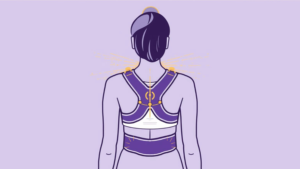Imagine this, after hours spent looking through spreadsheets, mind-numbing meetings, or brainstorming ideas for the next big thing, you finally push away from your desk device, only to realize your lower back has that same, familiar, nagging pain. You stretch out and move around a little, and with a distressed small sigh, it feels better. But your feeling of relief will only last so long. Honestly, even the best, ergonomically designed chairs stop feeling good when the lumbar support is gone.
For busy professionals who are busy juggling work, family, and self-care, this is not just uncomfortable; this is a daily obstacle. Lost lumbar support not only creates uncomfortable stiffness; it also robs you of your energy and focus during the day. And you may think to yourself, “My chair is still fine,” but even with wearing lumbar support, your body does not have a reliable support system.
Fortunately, if you know what to look for, you can learn to recognize “worn lumbar support,” which will help keep you one step ahead of chronic pain, and keep your body feeling strong and supported, whether you are closing deals, chasing kids, or catching up on emails.
Why Does Lumbar Support Matter in the Workplace?
1. Benefits of Proper Lumbar Support
Proper lumbar support keeps the trunk in a natural spine position reducing lower back strain; the support minimizes the fatigue of the muscles, and promotes better posture while sitting which can be difficult for a long time. Evidence shows that chairs designed with proper lumbar support create a more neutral pelvic and spine position [1].
2. Risks of Poor Lumbar Support
Insufficient lumbar support can produce a slumped posture, causing an increase in the risk of a musculoskeletal disorder. This bad posture can lead to chronic pain in the back, decreased productivity and potential long-term health impacts. Research has shown that when lumbar support is lacking, you are prone to discomfort and fatigue during prolonged periods of sitting. [2]
3. How Lumbar Support Affects Productivity and Health
Working in seats that are comfortable and provide proper lumbar support decreases physical discomfort and makes concentrating and getting work done easier. Ergonomically designed chairs contribute to higher productivity and less health-related work absences to employees [3].
What Are the 7 Warning Signs It’s Time to Replace Your Lumbar Support?
1. Persistent Lower Back Pain
Continuous discomfort in your lower back, especially after long periods of sitting, is one of the clearest signs that your lumbar support is no longer effective. As lumbar cushions lose their supportive properties over time, they can no longer maintain the natural curve of your spine, leading to muscle fatigue and spinal misalignment. Studies have shown that inadequate lumbar support can lead to chronic back pain and even long-term spinal health issues if left unaddressed [1].
2. Flattened or Deformed Cushion
If your lumbar cushion appears compressed, flattened, or misshapen, it’s a clear sign of wear and tear. A deformed cushion cannot provide the necessary support and may even contribute to poor posture. Deformation often occurs due to constant pressure, body heat, and prolonged use. Regularly inspect your cushion for shape retention, a supportive cushion should rebound and maintain its form after each use [2].
3. Fabric Wear and Tear
Visible signs like fraying, holes, or thinning fabric aren’t just aesthetic concerns. These issues can indicate a breakdown of the cushion’s structure and effectiveness. Over time, damaged fabric can also expose the inner foam to dust and moisture, accelerating degradation and reducing overall comfort and support [3].
4. Reduced Comfort and Support
If you start to feel the chair’s frame through the cushion, or if your lumbar support no longer feels as comfortable as it once did, it’s a strong indicator that the cushion has deteriorated. A well-functioning lumbar support should provide a balanced combination of firmness and cushioning to promote healthy posture and relieve pressure on the lower back.
5. Frequent Posture Adjustments
Do you find yourself constantly shifting your position, leaning forward, or slouching to find relief? This behavior can be a sign that your lumbar support isn’t providing the necessary stability and support. Effective lumbar support should help you maintain a comfortable and consistent posture without constant readjustments, which can contribute to muscle strain and fatigue [4].
6. No Adjustable Features Left
If the adjustable features of your lumbar support like height, firmness, or tilt settings no longer function correctly or have become stiff and difficult to operate, it may be time for a replacement. Functional adjustability is essential for personalized ergonomic support. When these features no longer work, your lumbar support loses its effectiveness, leaving you vulnerable to discomfort and posture issues [4].
7. It’s Over 1-2 Years Old
Even the highest-quality lumbar supports have a finite lifespan. After 1-2 years of regular use, the materials can begin to degrade, losing their shape and resilience. Regularly check your lumbar support for signs of wear, especially if you’ve been using it daily. Replacing it when it reaches the end of its lifespan can help maintain healthy posture and prevent the development of chronic back issues [5].
How Do You Choose the Right Replacement for Your Lumbar Support?
Ergonomic Features to Look For
When you are looking for a new lumbar support, you are going to want to consider ergonomic features that will meet your needs. Look for lumbar supports with adjusted height, firmness, or depth settings that allow you to find what is comfortable for you. Contoured designs offer better support by matching the natural curve of your spine, allowing you to sit in a neutral posture with greater comfort and less strain. Selecting breathable moisture-wicking materials will provide additional comfort and limit the temperature during long hours of work by reducing heating [6].
Material Quality and Durability
The quality of the materials used determine how effective the back support will be for you. Quality materials would include high density memory foam or comparable material that is supportive enough to hold its shape and conform to your lower back. It is important for lasting supportive material to be considered, as support needs to be consistent throughout the day. It’s also smart to consider the covers of the lumbar support. Looking for covers made with durable fabric, easy to clean, or even with antimicrobial treated fabric, such as polyester blends, will help ensure the life of your lumbar support, while resisting moisture, wear and bacteria build up.
Fit for Your Chair and Body Type
One aspect that is often ignored, or simply overlooked, is whether the lumbar support fits both the design of your chair and the dimensions of your body. It is possible for lumbar support to be misaligned with your chair’s design structure and/or it might not fit your lower back correctly. If your lumbar support does not fit you properly, it can do more harm than good. You are continually basing lumbar support selections on product dimensions and its compatibility features. If a lumbar support will not fit you well, it may not only not alleviate pressure on your spine, but may also increase your discomfort, or inhibit good posture, thus adding to facilitation of poor posture. If your lumbar support fits well your discomfort should decrease, and consequently improve comfort, and you improve your odds of maintaining good postural habits with limited attention.
What Simple Maintenance Tips Can Prolong Lumbar Support Life?
- Regularly clean the support to prevent dirt accumulation.
- Inspect for signs of wear or damage.
- Adjust settings to maintain optimal support.
- Avoid placing heavy objects on the support when not in use.
- Store in a dry, cool place to prevent material degradation.
- Rotate usage if possible to evenly distribute wear.
When Should You Consult a Professional?
1. Office Ergonomics Assessment
If you continue to have discomfort in your back even after adjusting the lumbar support in your chair, you may want to arrange to have an ergonomic assessment conducted by a professional ergonomist. Ergonomists have trained in how to analyze your work environments and setup, including things like your chair, desk, monitor height, and even your overall posture. They can make recommendations for changes based on your assessment, including the use of your lumbar support, and desk height, as well as recommending changes or accessories that may help you reduce strain and improve your comfort during your work day. An ergonomic assessment may also help to identify other issues you may not have considered, which are causing your discomfort.
2. Occupational Health Recommendations
If you continue to have discomfort which is not improving with changes around the workspace, you would be best served seeking out occupational health professionals who can conduct a full evaluation and examine any underlying issues (including muscle imbalances, repetitive strain injuries, or other pre-existing conditions that may have an adverse effect due to lack of support) and may suggest exercise, specific stretching, physical therapy for pain management, etc., in order to alleviate discomfort and solve further issues. In some cases, they might also provide recommendations for upgraded equipment to enhance all of your specifications related to your needs to your work environment [7].
Conclusion
Recognizing the signs of worn-out lumbar support is essential for maintaining comfort and preventing long-term health issues. Regular assessments and timely replacements ensure that your workspace remains conducive to productivity and well-being.
Frequently Asked Questions
1. Can bad lumbar support cause long-term back problems?
Yes, inadequate lumbar support can lead to chronic back pain and musculoskeletal disorders over time [2].
2. How often should I replace my lumbar pillow?
Typically, every 1–2 years, depending on usage and material quality [5].
3. Can I add extra lumbar support to my existing chair?
Absolutely. Many aftermarket lumbar cushions are designed to enhance existing chairs [6].
4. What should I look for in a replacement lumbar support?
Adjustability, durable materials, ergonomic design, and compatibility with your chair [6].
5. Can lumbar support affect productivity at work?
Yes, proper support can reduce discomfort, leading to improved focus and efficiency [3].
References
- Effect of office chair design features on lumbar spine posture, muscle activity and perceived pain during prolonged sitting
- The effects of chair intervention on lower back pain, discomfort and trunk muscle activation in office workers: a systematic review
- How Ergonomic Office Chairs Increase Productivity – Concept Seating
- An empirical study of preferred settings for lumbar support on adjustable office chairs
- The 11 Best Lumbar Support Pillows of 2024, Tested and Reviewed – Health.com
- Effectiveness of a lumbar support continuous passive motion device in the prevention of low back pain during prolonged sitting
- The effectiveness of a chair intervention in the workplace to reduce musculoskeletal symptoms: a systematic review























